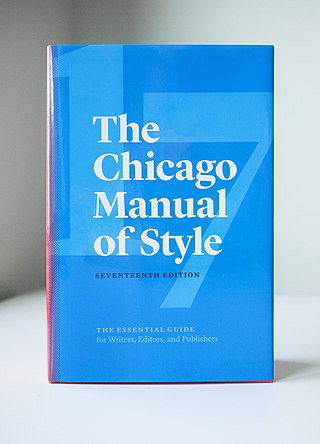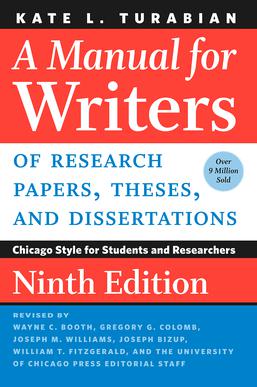Related Research Articles

The Chicago Manual of Style is a style guide for American English published since 1906 by the University of Chicago Press. Its 17 editions have prescribed writing and citation styles widely used in publishing. It is "one of the most widely used and respected style guides in the United States".
Interlibrary loan is a service that enables patrons of one library to borrow physical materials and receive electronic documents that are held by another library. The service expands library patrons' access to resources beyond their local library's holdings, serving as "an integral element of collection development" for libraries.

A library catalog is a register of all bibliographic items found in a library or group of libraries, such as a network of libraries at several locations. A catalog for a group of libraries is also called a union catalog. A bibliographic item can be any information entity that is considered library material, or a group of library materials, or linked from the catalog as far as it is relevant to the catalog and to the users (patrons) of the library.

Bibliography, as a discipline, is traditionally the academic study of books as physical, cultural objects; in this sense, it is also known as bibliology. English author and bibliographer John Carter describes bibliography as a word having two senses: one, a list of books for further study or of works consulted by an author ; the other one, applicable for collectors, is "the study of books as physical objects" and "the systematic description of books as objects".

This page is a glossary of library and information science.
MARC is a standard set of digital formats for the machine-readable description of items catalogued by libraries, such as books, DVDs, and digital resources. Computerized library catalogs and library management software need to structure their catalog records as per an industry-wide standard, which is MARC, so that bibliographic information can be shared freely between computers. The structure of bibliographic records almost universally follows the MARC standard. Other standards work in conjunction with MARC, for example, Anglo-American Cataloguing Rules (AACR)/Resource Description and Access (RDA) provide guidelines on formulating bibliographic data into the MARC record structure, while the International Standard Bibliographic Description (ISBD) provides guidelines for displaying MARC records in a standard, human-readable form.
ISO 690 is an ISO standard governing bibliographic references in different kinds of documents, including electronic documents. This international standard specifies the bibliographic elements that need to be included in references to published documents, and the order in which these elements should be stated.

Anglo-American Cataloguing Rules (AACR) were an international library cataloging standard. First published in 1967 and edited by C. Sumner Spalding, a second edition (AACR2) edited by Michael Gorman and Paul W. Winkler was issued in 1978, with subsequent revisions (AACR2R) appearing in 1988 and 1998; all updates ceased in 2005.

Functional Requirements for Bibliographic Records is a conceptual entity–relationship model developed by the International Federation of Library Associations and Institutions (IFLA) that relates user tasks of retrieval and access in online library catalogues and bibliographic databases from a user’s perspective. It represents a more holistic approach to retrieval and access as the relationships between the entities provide links to navigate through the hierarchy of relationships. The model is significant because it is separate from specific cataloguing standards such as Anglo-American Cataloguing Rules (AACR), Resource Description and Access (RDA) and International Standard Bibliographic Description (ISBD).

In library and information science, cataloging (US) or cataloguing (UK) is the process of creating metadata representing information resources, such as books, sound recordings, moving images, etc. Cataloging provides information such as author's names, titles, and subject terms that describe resources, typically through the creation of bibliographic records. The records serve as surrogates for the stored information resources. Since the 1970s these metadata are in machine-readable form and are indexed by information retrieval tools, such as bibliographic databases or search engines. While typically the cataloging process results in the production of library catalogs, it also produces other types of discovery tools for documents and collections.
A finding aid, in the context of archival science, is an organization tool, a document containing detailed, indexed, and processed metadata and other information about a specific collection of records within an archive. Finding aids often consist of a documentary inventory and description of the materials, their source, and their structure. The finding aid for a fonds is usually compiled by the collection's entity of origin, provenance, or by an archivist during archival processing, and may be considered the archival science equivalent of a library catalog or a museum collection catalog. The finding aid serves the purpose of locating specific information within the collection. The finding aid can also help the archival repository manage their materials and resources. The history of finding aids mirrors the history of information. Ancient Sumerians had their own systems of indexes to locate bureaucratic and administrative records. Finding aids in the 19th and 20th centuries were paper documents, such as lists or index cards. In the 21st century, they can be created in electronic formats like spreadsheets or databases. The standard machine-readable format for manuscript collection finding aids, widely used in the United States, Canada, the United Kingdom, France, Australia and elsewhere, is Encoded Archival Description.

Henriette Davidson Avram was a computer programmer and systems analyst who developed the MARC format, the international data standard for bibliographic and holdings information in libraries. Avram's development of the MARC format in the late 1960s and early 1970s at the Library of Congress had a revolutionizing effect on the practice of librarianship, making possible the automation of many library functions and the sharing of bibliographic information electronically between libraries using pre-existing cataloging standards.
The Linguistic Bibliography / Bibliographie Linguistique is an annual publication which first appeared in 1949. The publication provides comprehensive bibliographical descriptions of publications in theoretical linguistics, with about 20,000 items added per year. Since 2002, the database has also been available online, as Linguistic Bibliography Online, and contains data from 1993 onward.
Resource Description and Access (RDA) is a standard for descriptive cataloging initially released in June 2010, providing instructions and guidelines on formulating bibliographic data. Intended for use by libraries and other cultural organizations such as museums and archives, RDA is the successor to Anglo-American Cataloguing Rules, Second Edition (AACR2).
Describing Archives: A Content Standard (DACS) is a standard used for describing materials in archives. First adopted by the Society of American Archivists (SAA) in March 2004, DACS was updated with a Second Edition in 2013. DACS is broken down into a set of rules used in crafting archival descriptions, and guidelines for creating authority records in archives.

A Manual for Writers of Research Papers, Theses, and Dissertations is a style guide for writing and formatting research papers, theses, and dissertations and is published by the University of Chicago Press.
Ben Gu is a librarian, translator and library science researcher. He received his M.S. degree in Mathematics in Fudan University in 1987, and got his Ph.D. degree in Information Science in Renmin University of China in 2000. He translated many scholarly works in musicology, philosophy, history and library science, and compiled several books in library acquisitions and library cataloging. He was awarded by the State Council for his special contributions in library science.
BIBFRAME is a data model for bibliographic description. BIBFRAME was designed to replace the MARC standards, and to use linked data principles to make bibliographic data more useful both within and outside the library community.
The Regeln für die alphabetische Katalogisierung or RAK are a bibliographic cataloging set of rules. The RAK rules appeared for the first time in 1976 and became the dominant set of rules in Germany and Austria in the 1980s.
The (Statement of) International Cataloguing Principles (ICP) define(s) the foundation for the creation of bibliographical cataloging rules for libraries. The ICPs are an initiative of the International Federation of Library Associations and Institutions (IFLA) to modernize and replace the old Paris Principles (PP).
References
- Chan, Lois Mai (2007). Cataloging and classification : an introduction (3rd ed.). Lanham: Scarecrow Press. ISBN 978-0810860001.
- ISBD: International Standard Bibliographic Description (PDF). IFLA series on bibliographic control. Vol. 44 (Consolidated ed.). München: K.G. Saur. 2011.
- Svenonius, Elaine (2000). The intellectual foundation of information organization . Cambridge, Massachusetts: MIT Press. ISBN 9780262194334.
- Willer, Mirna; Dunsire, Gordon; Bosancic, Boris (2010). "ISBD and the Semantic Web". JLIS.it. University of Florence. 1 (2). doi:10.4403/jlis.it-4536. Archived from the original on 1 January 2012. Retrieved 29 June 2013.